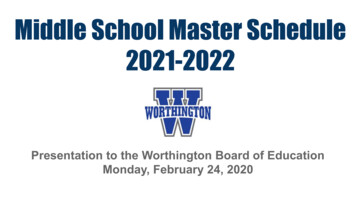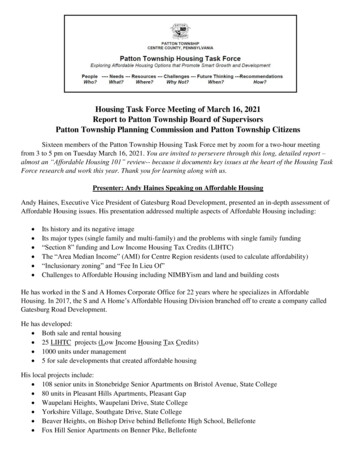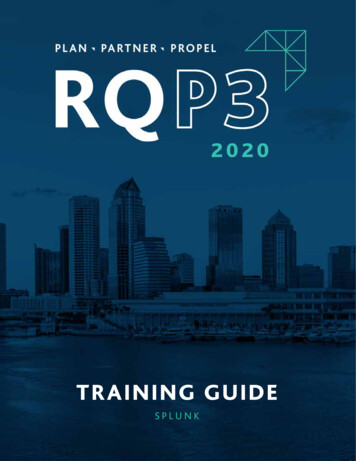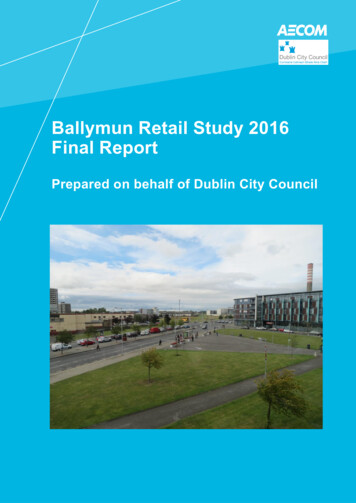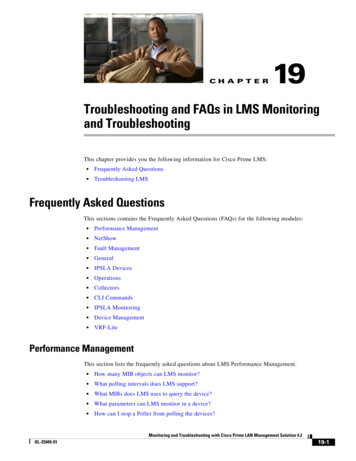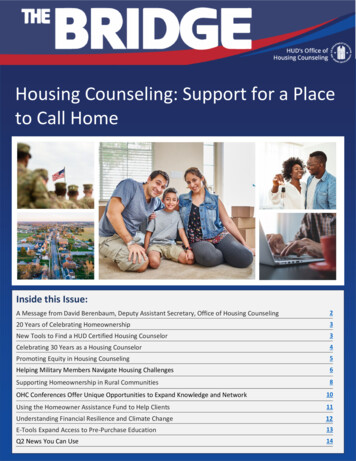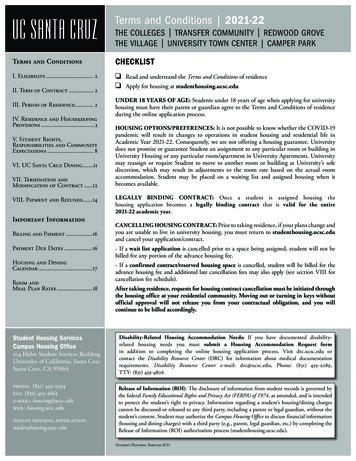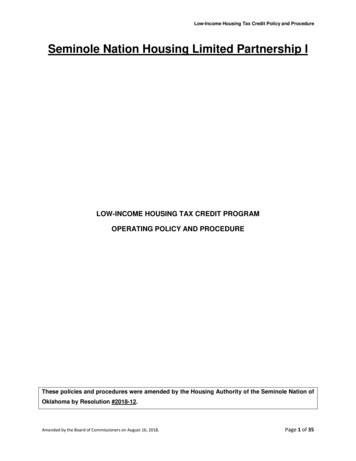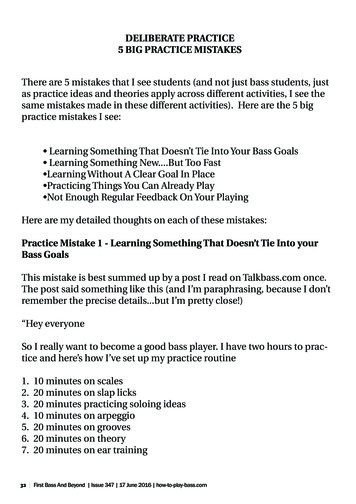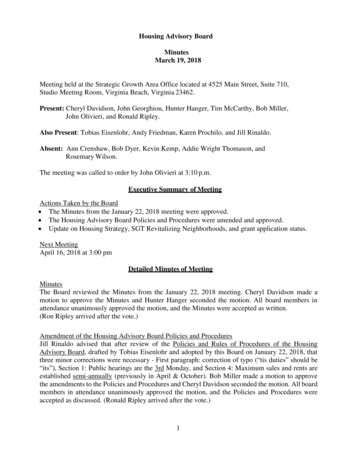
Transcription
Housing Advisory BoardMinutesMarch 19, 2018Meeting held at the Strategic Growth Area Office located at 4525 Main Street, Suite 710,Studio Meeting Room, Virginia Beach, Virginia 23462.Present: Cheryl Davidson, John Georghiou, Hunter Hanger, Tim McCarthy, Bob Miller,John Olivieri, and Ronald Ripley.Also Present: Tobias Eisenlohr, Andy Friedman, Karen Prochilo, and Jill Rinaldo.Absent: Ann Crenshaw, Bob Dyer, Kevin Kemp, Addie Wright Thomason, andRosemary Wilson.The meeting was called to order by John Olivieri at 3:10 p.m.Executive Summary of MeetingActions Taken by the Board The Minutes from the January 22, 2018 meeting were approved. The Housing Advisory Board Policies and Procedures were amended and approved. Update on Housing Strategy, SGT Revitalizing Neighborhoods, and grant application status.Next MeetingApril 16, 2018 at 3:00 pmDetailed Minutes of MeetingMinutesThe Board reviewed the Minutes from the January 22, 2018 meeting. Cheryl Davidson made amotion to approve the Minutes and Hunter Hanger seconded the motion. All board members inattendance unanimously approved the motion, and the Minutes were accepted as written.(Ron Ripley arrived after the vote.)Amendment of the Housing Advisory Board Policies and ProceduresJill Rinaldo advised that after review of the Policies and Rules of Procedures of the HousingAdvisory Board, drafted by Tobias Eisenlohr and adopted by this Board on January 22, 2018, thatthree minor corrections were necessary - First paragraph: correction of typo (“tis duties” should be“its”), Section 1: Public hearings are the 3rd Monday, and Section 4: Maximum sales and rents areestablished semi-annually (previously in April & October). Bob Miller made a motion to approvethe amendments to the Policies and Procedures and Cheryl Davidson seconded the motion. All boardmembers in attendance unanimously approved the motion, and the Policies and Procedures wereaccepted as discussed. (Ronald Ripley arrived after the vote.)1
Update on Grant ApplicationsAndy Friedman advised VB was not selected as one of the Bloomberg Champion Cities. No writtenfeedback for denial was provided, however, it was acknowledged that approximately 100 citiescompeted nationwide. Additionally, Andy stated that notice was received VB unfortunately will notbe moving forward in the DHCD Vibrant Communities grant application process either. It wasconveyed that our stormwater efforts were not considered to be enough of an Economic DevelopmentComponent. Lastly, he did inform that the VHDA Architectural Design Services grant has beensubmitted and looks promising.Housing StrategyAndy Friedman distributed the Outline of the Housing Strategy draft dated March 8, 2018(see attached). Time was given to all present to read the new document. The draft outlines currentCity-wide conditions and highlights strengths as well as areas that could use improvement. Six keycomponents of Strategy Implementation are identified as well as measures for identifying successfulresults.Karen Prochilo presented Housing Strategy: Land Use/Development Issues & Options (see attachedPowerPoint) and relayed DCM Ron Williams suggestions for improvement. The presentationproposes an integrated, systematic approach to revitalization in the Pilot Area and also offers creativedesign and zoning solutions. Karen shared that information gleaned from the PowerBI database hassignificantly enhanced knowledge of the three neighborhoods and will continue to be usefulthroughout the implementation process. (Demonstration of PowerBI will take place at next month’smeeting.) Once the PowerPoint has been presented to a variety of interested parties it will be revised,then as Citizen Engagement events begin to take place the Design Advisory Board will convene tobegin their work.Discussion: Bob Miller – Asked for clarification of the concept of 15 minute neighborhoods. (Responsefrom Karen Prochilo and Andy Friedman.) He then stated he felt it was a good idea as someneighborhoods are so large that living there may be a very different experience on one edge ofthe neighborhood vs. the opposite side. Andy Friedman – Our challenge is to design programs that suit homeowners’ needs. While wecannot help every single person, DHNP does its best to assess demand and seek out sources forfunding assistance. Karen Prochilo – DHNP currently offers similar programs to the ones that are proposed.Additionally, referrals are given to ineligible applicants for local faith based and non-profitgroups offering assistance. Bob Miller – A zoning overlay is the key to flexibility (i.e., Thalia neighborhood). He alsosuggested care should be taken during the design phase to put in measures to deter cut throughtraffic and perhaps add some pocket parks. Lastly, he said he would love to see Broadband madeavailable to all households as it is essential to our children’s education and future. Ron Ripley – Having support from neighborhood leaders is critical to project success. Andy Friedman – (referencing his prior handout) Reinforced that success will be intermittentlyevaluated based on Real Estate Assessments, Codes Violations, and Resident PerceptionSurveys. In an effort to preserve affordability an attempt will also be made to track AverageIncome Values.2
John Georghiou – Stigma related to infrastructure issues and emotional responses will definitelybe hurdles. The City will need to convince residents they are invested in their plight and thezoning changes and infrastructure upgrades are yielding positive results.Karen Prochilo – A representative from the City Attorney’s Office will be invited to attendfuture meetings pertaining to any potential zoning changes.John Olivieri – Since the flood there have been people buying multiple houses to flip.Conversely, there are residents who want to stay in their homes because they know they willhave to spend significantly more money to obtain a comparable home/neighborhood elsewhere.Hunter Hanger – Offered to use his real estate software and professional connections to obtaingreater data into activity within the Pilot Area. He also suggested partnering with realtors as aresource for dissemination of information to potential buyers about available programs andsuggested renovation practices.Andy Friedman – Streets are the first part of the stormwater system so water will begin to pondthere. Success will be measured by reducing how high the water gets and subsequently thedamage to homes, and by measuring how quickly the water dissipates. Once we educatehomeowners on this way of thinking and show them ways to protect their property then theywill begin to feel more comfortable with the effect of coastal weather patterns in theirneighborhood.Karen Prochilo – Requested everyone review the handout copy of her presentation and provideany additional feedback to her via email. She also said they intend to hold the first meeting ofthe Design Committee in April 2018.Next Meeting:April 16, 2018 (3:00-5:00 p.m. at the Strategic Growth Area Office)The meeting adjourned at 4:29 p.m.Jill RinaldoRecording Secretary3
DRAFT - Outline of the Housing Strategy – 3/8//18Purpose: The purpose of the housing strategy is to put in place long-termactivities that ensure that over time, we have a vibrant housing market with risingvalues, neighborhoods are revitalized, and Virginia Beach’s housing continues tobe attractive to a wide range of current occupants and future potential buyers ofall ages and generations, and competitive with other cities to attract businessesand their employees.Council’s goal #4: Revitalize Neighborhoods and Plan for the FutureProposed Goal from the Virginia Tech Needs Assessment and Housing MarketAnalysis: A vibrant housing market with rising values that creates prosperity andrevenue with which to support affordabilityUnderstanding Housing and Neighborhoods: All housing exists in aneighborhood, and that neighborhood’s characteristics have a strong impact onthe individual housing unit. To achieve a vibrant housing market we must ensurethat neighborhoods are vital and well-maintained. Therefore, a housing strategydepends in part on a neighborhood revitalization strategy, and vice versa,although for each one there are overlaps and areas of separation.Theory of good neighborhoods: Every buyer and renter wants to live in a goodneighborhood. Years of asking people what that means tell us that there aresome fundamentals without which you can’t have a good neighborhood: safetyfrom crime, both real and perceived; quality public infrastructure (streets,drainage, sidewalks) and public services including waste management; wellmaintained private property; stability in uses (zoning controls); and qualityschools. These are the basics. Virginia Beach already does these well in almost allareas.Current citywide conditions: Overall good housing stock condition (80% well maintained on the exterior)Overall many stable neighborhoodsVery safe cityContinued high level of public servicesContinued investment in infrastructure maintenance and repair1
But: there are threats and evidence of weakness in certain areas, including: bubble of housing built in 1970-1990 is all of one type, all aging, andconcentrated in areas affordability of that housing for a high percentage of current owners isdifficult, meaning possibly not enough reinvestment is occurring/will occur the design and type of housing and its amenities are not necessarilyattractive to current/new buyers; there are affordability and process barriers to purchase/rehab for newgenerations of buyers who may otherwise want them There is a limited supply of housing in “15 minute communities” withlive/work/play There are many older householders with fixed incomes in someneighborhoods Sea level rise and recurrent flooding create a range of threats that alsoaffect some of the already- threatened areas, and these threats interactwith the other threats, and actually converge in some of the threatenedneighborhoods, including: Damage from storms and cost of rehab/recovery Fear of future storm events/damage Rising flood insurance costs Cost of mitigating future damage on individual houses (includingelevation of houses, the need for flood vents, raising HVAC systems,re-grading yards, fixing backyard drainage ditchesAnd there are many current strengths and opportunities:Safety, schools, infrastructure, public services, responsive Council, financiallycapable government, pro-active code enforcement, pro-active Police Dept; nowrising property values citywideKey considerations:What is proposed are almost all long-term strategies where impacts won’t startto be seen for 3-5 years, but then the impacts will solidify and should accelerateBecause VB has been doing most of the things required for good housing andgood neighborhoods, we don’t see evidence of deterioration either in2
neighborhoods or the housing market. We are in the prevention business and itis harder to measure prevention than remediation.The threats we see do not affect all areas equally. Both housing strategies andneighborhood revitalization must be applied selectively, using the proposedmeasurement tools below; many areas of the city have a bright future withoutany additional external action needed.Developing and testing housing and neighborhood strategies in a limited area willgive us a template for future actions, and will both limit our exposure to risk andincrease the possibility of success.Therefore, taking into account all the above, the following sets of activities areproposed to try to counter weaknesses, support existing strengths, and takeadvantage of opportunities.Six Key Pieces of the Strategy:1. Continue What We’re Doing: Because Virginia Beach already has been doingmost of the things required to have good housing and good neighborhoods perthe theory of good neighborhoods above, the most important housing andneighborhood strategy piece is to maintain all of those activities (publicsafety, public infrastructure, public services, code enforcement and qualityschools) and ensure that they continue to have the capability needed for newchallenges2. Assist Current Homeowners: Assisting current homeowners to re-invest intheir housing through a low-cost loan program is the single most importantstrategy that can have both short term and long-term concrete results.a. Loans to homeowners can help them do any/all of the activities to counterthe threats/issues that affect them, including: need to repair flood damage;need to modernize to address aging; need to mitigate future floodvulnerability; need to fix yards and backyard ditches to improve drainage;need for accessibility for aging in place;b. hazard mitigation will reduce flood insurance costs, which will in turnincrease affordability.c. Loans to homeowners are more effective than tax incentives because theyprovide up-front funding for the large costs they need to address.3
d. Loans to homeowners reduce total city investment because they are paidback over time whereas tax incentives are not recoverede. Loans to homeowners can individually address affordability, with terms ofthe loan tailored to individual capability to repayf. The city has been making loans to homeowners for 30 years and has all theinfrastructure in place to do thisg. Loans to homeowners are controllable and recoverable and can be tailoredto the needs that individuals haveh. With the city involved in the loan transaction, we can implement designrequirements that go along with the loan, so that all work effectivelyaddresses key goals, including hazard mitigation, design guidelines, etc.i. The City’s stormwater investments and disaster recovery planningdemonstrate a strong commitment to improvement that can helpleverage outside funding for homeowner loans. DHNP is working to obtainstate and private funding that can significantly expand the pool of funds3. Create and Demonstrate new Housing Designs. New designs are critical toguide remodeling and re-building toward resiliency and attractiveness. We areapplying for a VHDA grant to support hiring design professionals. We willutilize a combined city/developer/resident task force to guide the work of thedesign professional.a. New designs can then be incentivized for homeowners. All worksupported by homeowner loans will be required to comply with newdesigns.b. New designs can be incentivized for developers (see next item)c. Modify and/or create new designs for higherdensity/modern/resilient/walkable/appealing housing in areassurrounding low density neighborhoods and along main thoroughfares.d. Provide design guidelines to all stakeholders to reduce their need toobtain architectural and design assistance4. Create and/or Modify Existing Incentives for Developersa. We have many examples of development incentives that have beenutilized to achieve city goals over timeb. We have affordability programs through DHNP and the ability toleverage other affordability programs from various outside sources.c. A City-leadership level discussion of how to approach this issue is needed4
d. Developer incentives will require adherence to design guidelines andaffordability goals, and alignment with neighborhood revitalizationplans.5. Modify Zoning and Development Requirements to Remove Barriers to and/orIncentivize Desired development types. Virginia Beach has moved strategicallyto modify zoning in the resort area and in the Pembroke SGA. To achieve thegoals above, zoning and development requirements must be reviewed andmodified to insure they allow new designs, new styles and types of housing,new densities in appropriate locations, while continuing to protect existingneighborhoods. This will require extensive stakeholder interactions and thesame level of effort exerted for the SGA work in order to be successful.6. Develop a Comprehensive Plan for the Area taking into account all of theabove factors. The NRSGT has the capability to do this and has started downthe road with a design charrette and resident engagement.Implementation: The Pilot ProjectI recommend that we test the Housing Strategies and NeighborhoodRevitalization Strategies in Windsor Woods, Princess Anne Plaza and The Lakes:Given the damage caused by Hurricane Matthew in the WindsorWoods/Plaza/The Lakes area, and given that these areas are also some of thosemost threatened by aging housing, affordability and design issues, and given theCouncil’s investment in storm water improvements for these areas, they are boththe most urgent areas to address and most threatened, and have the mostopportunities. This test will give us a great deal of information with which tocreate a template for ongoing future revitalization activities as well as formodifications of the elements of the housing strategy. This template will be a keypart of helping us to achieve ongoing neighborhood revitalization successes.How to Measure Results:As proposed by our SGT, and modified upon discussion with DCM Williams, wepropose four key indicators of success:1) How real estate assessments by neighborhood change over time, ascompared to the trend in the overall city, is the best overall indicator of how5
the market overall values an area and the housing in it. We have the systemalready in place to do this. However, this is in many ways a “trailing”indicator because we don’t obtain the data until 18 months after the fact.2) Exterior physical condition of the housing and properties, as measured bysurveys done by code enforcement, consistent with surveys done over thepast 35 years.3) Surveys of the residents of key perceptions of their neighborhoods –starting with questions already in the citizen satisfaction survey and addinga few; but expanded to provide statistical reliability on the neighborhoodlevel.4) Change in income level of residents. We want to monitor overall incomelevels and if possible become aware of and help avoid major changes indemographics, whether gentrification or a downward turn in incomes.While our actions may not specifically influence this, it is important tomonitor it and be able to react.In addition, it would be desirable to collect and report on more real-time housingmarket data from the REIN/MLS system, and we will work to develop that.AMF 0Strategy.docx6
HOUSING STRATEGY: LAND USE /DEVELOPMENT ISSUES & OPTIONSPresentation for Housing Advisory BoardMarch 19, 2018Department of Housing &Neighborhood Preservation
THREATS TOOUR HOUSING& CITIZENS CRYFOR HELP!HOUSING STUDY IDENTIFIED: REINVENT HOUSING STOCKEXISTING HOUSING NOT AFFORDABLEEXISTING HOUSING NOT ATTRACTIVE TOFIRST TIME HOME BUYERSCITIZENS IN NEED: FLOODING AGING HOUSING STOCK AGING INFRASTRUCTURE FINANCIAL CONSTRAINTS RED TAPE
INTEGRATED APPROACHUtilized Resources in the CityINTEGRATED*: Combining things, people orideas of different types in one effective unit,group or system Housing Study– Housing Implementation Strategy *MacMillian dictionaryWorking with ConsultantCoordinating with other entities Neighborhood Revitalization– Departments working together–Meeting with the Community Disaster Recovery & Hazard Mitigation– Understanding what the Office ofEmergency Management has donethus far and what gaps need to befilled– Creating a plan to address those gaps Stormwater CIP Data – Power BI
SYSTEMS APPROACHUtilized People in Our Departments Access to affordablehousing, aging housingstock, affordablereinvestmentNeighborhoodRevitalization - NewZoning Options, Housing& Site Design GuidelinesSTRATEGIC GOAL TEAM 4 (SGT4)–SGT Sub-teams: Community Engagement,Data,Finance,Infrastructure,Public Services,Zoning-Land Use,MULTI- DEPARTMENTAL CHARRETTE–Staff Program Development Workshop October 2017:Staff becomes familiar with areas and issues–Pre-Community EngagementOpportunities for Resources GRANTS–Bloomberg Grant submitted January 2018–Vibrant Community Impact Grant submitted January2018–Community initiative Grant for design submittedMarch 2018
MAPPED OUT A PLANIDENTIFIED PILOT AREA: CURRENT CIP PROJECTSVULNERABLE TO THREATSFLOODED AREASIDENTIFIED IN HOUSING STUDYSTORMWATER DRAINAGE PROJECTS IDENTIFIED AREAS– Princess Anne Plaza– The Lakes– Windsor Woods
PILOT AREA:HURRICANE MATTHEW ESTIMATED DAMAGE** From Office of Emergency Management
DID OUR HOMEWORKDEMOGRAPHICS INCOME LEVELSMULTI GENERATIONALZONING / LAND USE PREDOMINATELY R-7.5 SINGLE FAMILY NEIGHBORHOOD HISTORY–Farmers did not farm here–1970s Construction was Pre-Flood Insurance Rate Maps SEA LEVEL RISE SURROUNDING DEVELOPMENT CONTRIBUTED TO STORMWATERISSUES LIMITED STORMWATER CONTROLS I-264 CONSTRUCTIONCODE ENFORCEMENT SURVEYRELATIONSHIPS TO CITY DOCUMENTS COMPREHENSIVE PLAN Housing & Neighborhood Chapter Environmental Stewardship Chapter Technical Report STRATEGIC GROWTH AREA: ROSEMONT PLAN OUTDOORS PLAN Capital Improvement Plan
PILOT AREA:ZONING
PRINCESS ANNE PLAZANEIGHBORHOOD CONDITIONS
WINDSOR WOODSNEIGHBORHOOD CONDITIONS
THE LAKESNEIGHBORHOOD CONDITIONS
NEIGHBORHOODREVITALIZATIONCHARRETTEEnvision - Identify/Analyze – DesignOctober 12, 2017 - SGA StudioGoal: A more vibrant, attractive, competitiveand resilient future for neighborhoods wherecurrent residents see a bright future and futureresidents.Objective: Address identified opportunities witha comprehensive and innovative approach inthree selected neighborhoods to achievephysical, financial & social/health stability.
MULTIDEPARTMENTALCHARRETTE PROCESSInvolved City DepartmentsDepartment of HousingPlanning & CommunityDevelopment (Comprehensive,Current & SGA Office)Emergency ManagementPoliceInformation TechnologyPublic WorksLibrariesReal Estate Assessors OfficeManagement ServicesPublic UtilitiesMedia & CommunicationsSTIR OfficeParks & RecreationVirginia Beach City SchoolsVolunteer Resources
Identified Pilot Program Areas Princess Anne Plaza: Potential fordevelopment on ball fields & open spaceareas prone to flooding - opportunity anaffordable model home site with floodresistance designs - Create a Windsor Lake& Old Forge Road Greenway - Golf CourseClub House is a landmark location withpossibility to become an educational facility The Lakes: Potential developmentopportunities along Holland Road Windsor Woods: Most flooded homes Potential to incentivize development - FloodResistant Opportunities
CONNECTIVITY & OPEN SPACE CONNECTIONS ARE IMPORTANT– Transportation– Recreational INTEGRATION OF OPEN SPACE– Passive Recreational Areas Multi- Use Visual– Linear greenways Potential for connectivity
EXAMPLES OF RESIDENTIAL UNIT TYPES– DUPLEXES
EXAMPLES OF RESIDENTIAL UNIT TYPES– QUADS / TOWNHOMES
PILOT NEIGHBORHOODS CHALLENGES& OPPORTUNITIESCHALLENGES Cost of Improvements Appropriate improvements thatblend with the existing features &valuesOPPORTUNITIES Infrastructure Improvements (CIP)– Canoe Launches– Pocket Parks– Picnic Areas– Sidewalk Connections Proposed Rehabilitation Programs– Disaster Relief– Middle Gap Improvement Program– Manufactured /Mobile Homes Rehab Partnerships Incentives to Create a Vision
LAND USEISSUES FLOOD PLAIN MANAGEMENT DENSITY SETBACKS SITE REQUIREMENTS DESIGN GUIDELINES COMPATABILITY
COMMUNITY ENGAGEMENT An integral part of the planning and execution strategy. Virginia Beach has partneredwith Old Dominion University on an engagement effort in regard to stormwater andflooding. Staff are committed to planning with residents. We have started a subcommitteeand will expand to a joint planning committee to initiate a plan developmentprocess. Investment in www.publicinput.com will allow citizens to engage on the go. VirginiaBeach will involve stakeholders in the process to plan and design key elements ofwhat will be a replicable template
FUNDING OPTIONSEXISTING Flood Mitigation Assistance (SRL-FMA Grant Program) HUD Funded Owner-Occupied Rehabilitation ProgramPROPOSED City Funded Low Interest Loans (Sliding Scale) – City Administered Disaster Relief Middle Gap Improvement Program Bloomberg Grant submitted January 2018 DHCD Vibrant Community Impact Grant submitted January 2018 VHDA Community Initiative Grant submitted March 2018
NEXT STEPSIDENTIFYOPTIONS FORZONING &LAND USEMarchBRIEFINGS:HousingAdvisory Board,PlanningCommission,March / AprilCREATION OF ADESIGNADVISORYBOARDMarch / AprilCOMMUNITYENGAGEMENTApril / MayCOMMUNITYPLANNINGPROCESSOngoingCREATION OFPROGRAMSApril / MayFINANCINGPACKAGES INPLACEMayPROGRAMSREADY TOBEGINJuneQUESTIONS / COMMENTS
Analysis: A vibrant housing market with rising values that creates prosperity and revenue with which to support affordability Understanding Housing and Neighborhoods: All housing exists in a neighborhood, and that neighborhood's characteristics have a strong impact on the individual housing unit. To achieve a vibrant housing market we must ensure
